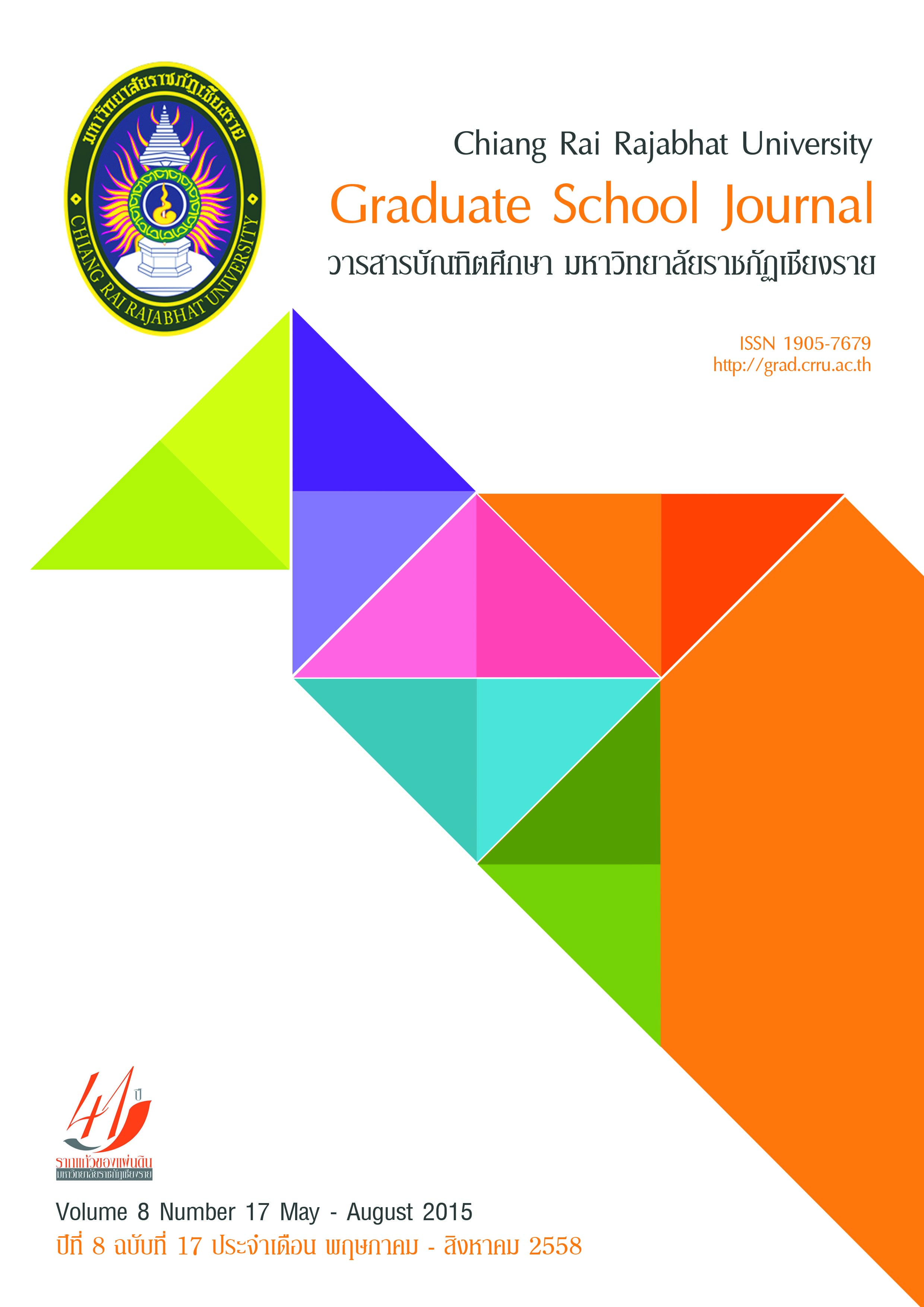การพัฒนาทักษะการพูดภาษาไทยที่ใช้ในชีวิตประจำวันด้วยแบบฝึกทักษะที่ใช้วิธีการสอนแบบทางตรง (Direct Instruction Model) สำหรับนักศึกษาจีน มหาวิทยาลัยราชภัฏเชียงราย
Main Article Content
บทคัดย่อ
ประชากรที่ใช้ในการวิจัยครั้งนี้ ได้แก่ นักศึกษาจีนที่เรียนในหลักสูตรภาษาไทยเพื่อการศึกษาภาคเรียนที่ 2 ปีการศึกษา 2556 ของมหาวิทยาลัยราชภัฏเชียงราย จำนวน 18 คน เครื่องมือที่ใช้ในการเก็บรวบรวมข้อมูล ประกอบด้วย แบบฝึกทักษะการ พัฒนาทักษะพูดภาษาไทยที่ใช้ในชีวิตประจำวันที่ใช้วิธีการสอนแบบทางตรง (Direct Instruction Model)สำหรับนักศึกษาจีน มหาวิทยาลัยราชภัฏเชียงราย จำนวน 8 แบบฝึก แผนการจัดการเรียนรู้ประกอบมาตรฐานคุณภาพระดับอุดมศึกษา (มคอ. 3) จำนวน 8 แผน แบบทดสอบหลังเรียนแบบปรนัยจำนวน 40 ข้อ แบบประเมินทักษะความสามารถด้านการพูดภาษาไทยที่ใช้ใน ชีวิตประจำวัน 8 สถานการณ์ และแบบวัดความพึงพอใจของนักศึกษาจีนที่ได้รับการพัฒนาทักษะการพูดภาษาไทยที่ใช้ในชีวิต ประจำวันด้วยแบบฝึกทักษะที่ใช้วิธีการสอนแบบทางตรง (Direct Instruction Model) สำหรับนักศึกษาจีน มหาวิทยาลัยราชภัฏ เชียงราย แบบมาตราส่วนประมาณค่า จำนวน 15 ข้อ และแบบเปิด 1 ข้อ วิเคราะห์ข้อมูลโดยการหาค่า E1/E2 ค่าเฉลี่ย ร้อยละ และส่วนเบี่ยงเบนมาตรฐาน
ผลการวิจัย พบว่า
1. ประสิทธิภาพของแบบฝึกทักษะการพูดภาษาไทยที่ใช้วิธีการสอนแบบทางตรง (Direct Instruction Model) สำหรับ นักศึกษาจีน มหาวิทยาลัยราชภัฏเชียงราย มีประสิทธิภาพ (E1/E2 ) 82.43/83.26 ซึ่งสูงกว่าเกณฑ์ที่กำหนดไว้ 80/80
2. ทักษะทางการเรียนก่อนเรียนกับหลังเรียนของผู้เรียนหลังได้รับการพัฒนาทักษะการพูดภาษาไทยที่ใช้ในชีวิตประจำ วันด้วยแบบฝึกทักษะที่ใช้วิธีการสอนแบบทางตรง (Direct Instruction Model) สำหรับนักศึกษาจีน มหาวิทยาลัยราชภัฏ เชียงราย มีคะแนนเฉลี่ยเพิ่มขึ้นร้อยละ 25.41
3. ผู้เรียนมีความพึงพอใจต่อการพัฒนาทักษะการพูดภาษาไทยด้วยแบบฝึกทักษะที่ใช้วิธีการสอนแบบทางตรง (Direct Instruction Model) สำหรับนักศึกษาจีน มหาวิทยาลัยราชภัฏเชียงราย ภาพรวมอยู่ในระดับมากที่สุด
The Development of Daily Conversational Thai Learning Packages with Direct Instruction Model for Chinese Students, Chiang Rai Rajabhat University
This research aimed to validate the efficiency of Daily Conversational Thai Learning Packages with Direct Instruction Model for Chinese Students, Chiang Rai Rajabhat University, according to standard criteria 80/80 by comparing the pre-test and posttest scores of the learners. Meanwhile, it also revealed the satisfaction of the students toward the developed packages.
Eighteen Chinese students, enrolled in Thai Language for Education Program in the second semester of academic year of 2013, Chiang Rai Rajabhat University, were selected as the population of the study. The data was collected by using the following tools; 8 lessons of Daily Conversational Thai Learning Packages with Direct Instruction Model for Chinese students and their evaluation forms, TQF 3, a set of multiple-choice test (40 items) and a satisfaction evaluation form which contained 15 items of rating scale questions and a subjective question. The data was analyzed according to E1/E2 method, mean, percentage, and standard deviation.
The study revealed that;
1. The efficiency of Daily Conversational Thai Learning Packages with Direct Instruction Model for Chinese Students, Chiang Rai Rajabhat University was at 82.43/83.26 (E1/E2 ) which is higher than the standard criteria.
2. The average score of the Chinese students’ posttest was increased by 25.41 percent after the application of Daily Conversational Thai Learning Packages with Direct Instruction Model.
3. The satisfaction toward the use of Daily Conversational Thai Learning Packages with Direct Instruction Model was at the highest level.
Article Details
บทความที่ได้รับการตีพิมพ์เป็นลิขสิทธิ์ของวารสารมหาวิทยาลัยราชภัฎเชียงราย
ข้อความที่ปรากฏในบทความแต่ละเรื่องในวารสารวิชาการเล่มนี้เป็นความคิดเห็นส่วนตัวของผู้เขียนแต่ละท่านไม่เกี่ยวข้องกับมหาวิทยาลัยราชภัฎเชียงราย และคณาจารย์ท่านอื่นๆในมหาวิทยาลัยฯ แต่อย่างใด ความรับผิดชอบองค์ประกอบทั้งหมดของบทความแต่ละเรื่องเป็นของผู้เขียนแต่ละท่าน หากมีความผิดพลาดใดๆ ผู้เขียนแต่ละท่านจะรับผิดชอบบทความของตนเองแต่ผู้เดียว


